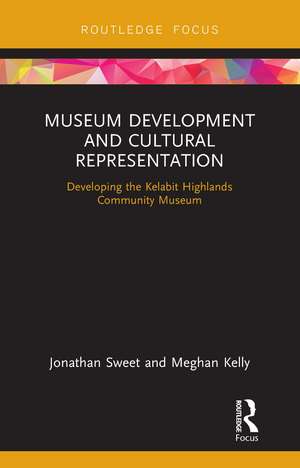Museum Development and Cultural Representation: Developing the Kelabit Highlands Community Museum
Autor Jonathan Sweet, Meghan Kellyen Limba Engleză Hardback – 2 oct 2018
Building on their direct involvement in the development of the project, the authors appraise the process in retrospect through a thematic analysis. Themes covered include the project’s local and international contexts, community involvement and agency, the balance of tourism and authenticity, and the role of non-local partners. Through their analysis, the authors unpack the complexities of cultural representation and identity in heritage design practice, and investigates the relationship between capacity building and agency in cultural heritage management.
Situating the project within international trends in museology, Museum Development and Cultural Representation offers a valuable case example of a heritage-making process in an indigenous community. It will be of interest to scholars and students studying cultural representation, as well as communities and museum professionals looking to develop similar projects.
| Toate formatele și edițiile | Preț | Express |
|---|---|---|
| Paperback (1) | 136.80 lei 6-8 săpt. | |
| Taylor & Francis – 30 iun 2020 | 136.80 lei 6-8 săpt. | |
| Hardback (1) | 337.64 lei 6-8 săpt. | |
| Taylor & Francis – 2 oct 2018 | 337.64 lei 6-8 săpt. |
Preț: 337.64 lei
Preț vechi: 386.42 lei
-13% Nou
Puncte Express: 506
Preț estimativ în valută:
64.61€ • 67.64$ • 53.46£
64.61€ • 67.64$ • 53.46£
Carte tipărită la comandă
Livrare economică 05-19 aprilie
Preluare comenzi: 021 569.72.76
Specificații
ISBN-13: 9781138554351
ISBN-10: 1138554359
Pagini: 140
Ilustrații: 9
Dimensiuni: 138 x 216 x 15 mm
Greutate: 0.42 kg
Ediția:1
Editura: Taylor & Francis
Colecția Routledge
Locul publicării:Oxford, United Kingdom
ISBN-10: 1138554359
Pagini: 140
Ilustrații: 9
Dimensiuni: 138 x 216 x 15 mm
Greutate: 0.42 kg
Ediția:1
Editura: Taylor & Francis
Colecția Routledge
Locul publicării:Oxford, United Kingdom
Cuprins
- A unique cultural museum
- Shaping Kelabit conservation processes in Southeast Asia
- History, knowledge and the representation of identity
- Museum development and tourism: identifying authenticity and representation
- Indigenous knowledge in community museum practice
- Shaping the discussion on conservation
- The development of the Kelabit Highlands Community Museum
- Detailed encounters
- Concluding remarks
Notă biografică
Jonathan Sweet is a researcher and teacher of Museology, Cultural Heritage and Development at Deakin University, Australia.
Meghan Kelly is a Senior Lecturer in Visual Communication Design at Deakin University, Australia, and currently serves as the Associate Head of School for Teaching and Learning in the School of Communication and Creative Arts.
Meghan Kelly is a Senior Lecturer in Visual Communication Design at Deakin University, Australia, and currently serves as the Associate Head of School for Teaching and Learning in the School of Communication and Creative Arts.
Descriere
Museum Development and Cultural Representation critically examines the development of a museum and cultural heritage centre in the indigenous Kelabit Highlands in Sarawak, Malaysia.
Building on their direct involvement in the development of the project, the authors appraise the process in retrospect through a thematic analysis. Themes covered include the project’s local and international contexts, community involvement and agency, the balance of tourism and authenticity, and the role of non-local partners. Through their analysis, the authors unpack the complexities of cultural representation and identity in heritage design practice, and investigate the relationship between capacity building and agency in cultural heritage management.
Situating the project within international trends in museology, Museum Development and Cultural Representation offers a valuable case example of a heritage-making process in an indigenous community. It will be of interest to scholars and students studying cultural representation, as well as communities and museum professionals looking to develop similar projects.
Building on their direct involvement in the development of the project, the authors appraise the process in retrospect through a thematic analysis. Themes covered include the project’s local and international contexts, community involvement and agency, the balance of tourism and authenticity, and the role of non-local partners. Through their analysis, the authors unpack the complexities of cultural representation and identity in heritage design practice, and investigate the relationship between capacity building and agency in cultural heritage management.
Situating the project within international trends in museology, Museum Development and Cultural Representation offers a valuable case example of a heritage-making process in an indigenous community. It will be of interest to scholars and students studying cultural representation, as well as communities and museum professionals looking to develop similar projects.
